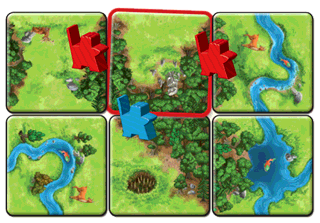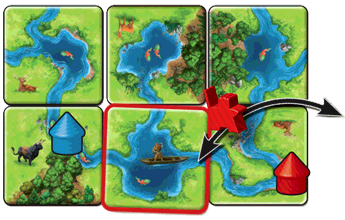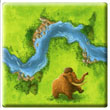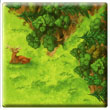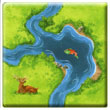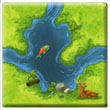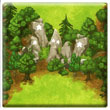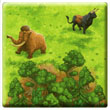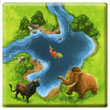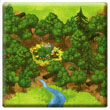Vânători și culegători: Jocul de bază
Cu mii de ani înainte ca oamenii din Carcassonne să fi construit ziduri și castele puternice, strămoșii lor populau ținutul. Aceștia vânau animale sălbatice, culegeau bace și prindeau pești pentru a își asigura supraviețuirea zilnică și prosperitatea continuată. Chiar și în ziua de azi, picturi rupestre fantastice și date preistorice stau mărturie pentru viața vibrantă care a existat în urmă cu multe generații.
Informații generale și comentarii
A doua ediție a jocului Vânători și culegători a fost lansată de Hans im Glück în 2020. Este un joc inteligent de plasare a cartonașelor pentru 2-5 jucători, cu vârste de 8 ani în sus. Jocul Vânători și culegători (a doua ediție) fost lansat de Lineart cu reguli traduse în limba română.
Ceea ce urmează este bazat pe versiunea ZMG a regulilor în engleză din 2020, cu orice erori evidente corectate, iar orice variații față de versiunea originală Hans im Glück incluse ca note de subsol.
Conținut
- 79 land tiles (including one starting tile) with forests (including some forests with menhirs (*)), rivers, and lakes with fish, surrounded by grassland with animals.
(*) A menhir is a massive stone block erected by prehistoric humans,
derived from "men" meaning "stone" and "hir" meaning "long". [1]
Overview
Each turn, you place land tiles to create a vast landscape of forests and grasslands. These grasslands include grazing animals, as well as rivers and lakes full of fish. You must strategically place your tribe members on these tiles to reap the bounty of the forests, grasslands, rivers, and lakes for your tribe. When you do, you will score points both during the game and at the end. After final scoring, the player with the most points wins the game!
Preparation
Place the starting tile (the back with a dark "C") faceup in the middle of the table. Separate the regular land tiles from the menhir tiles by back. Shuffle the menhir tiles and set them aside facedown in a stack. Shuffle the regular tiles and place them facedown in multiple stacks so that each player can easily reach at least 1 stack.
Place the scoreboard near the edge of the table, away from the starting tile.
Finally, each player gets Tribe Members (called "meeple(s)" in the rules). There are 30 meeples, 6 each in yellow, red, green, blue, and violet. There are also 15 huts, 3 in each colour.
Give each player 5 meeples and 3 huts in the colour of their choice.
Place the sixth meeple of each colour in use on the 0 space of the scoreboard. Return any unused meeples and huts to the box.
Playing the game
The youngest player takes the first turn, and play continues clockwise until the land tiles run out.
The current player performs the following actions in order, before continuing to the next player’s turn:
Rivers and Lakes
2a. Place a Meeple as a Fisher on a River
They cannot place a meeple on the river on the left side of the lake, because your meeple is already on that river.
2b. Place a Hut on a River or Lake
Instead of placing a meeple, you may place a hut on either a river or a lake on the tile you just placed, but only if no other huts are present on the same river system.
A river system consists of all rivers connected to each other, including through lakes. While individual rivers end at lakes, rivers are connected to each other through lakes for the purpose of a river system. River systems end only at unconnected tile edges and forests.
Huts can be placed only on rivers or lakes. Huts remain where they are placed until the end of the game.
3. Scoring a river
A river is completed when both ends are closed by lakes or forests, or when it loops back onto itself by connecting to the other end. When a river is completed, it is scored. If one of your meeples is on a river when it scores, you will score points from it, regardless of who placed the tile that completed the river.
You score 1 point for each tile comprising the completed river, and 1 additional point for each fish present in the river and any lakes that close it. . After scoring, return the meeple(s) on the completed feature to their owner’s supply.
You have a meeple on the river, so you score 5 points: 3 points for the 3 tiles forming the river, and 2 for the 2 fish in the lakes.
Players track their scores using the meeples placed on the scoreboard at the start of the game. When you score points, advance your meeple that many spaces on the scoreboard. If your meeple passes the “0” space on the scoreboard, take a scoring marker and place it in front of you with the “50” side face-up. If your meeple passes the “0” space again, flip the marker to the “100” side.
These 3 steps are the general rules of the game. Other features have some important differences, explained below.
Forests
2. Place a Meeple as a Gatherer on a Forest
You may place a meeple on a forest tile you just placed as a gatherer. As with rivers, a meeple can be placed on a forest only if there are no other meeples present on that forest.
3. Score a completed forest
Normal Forest Scoring
A forest is completed when it is surrounded by grassland and has no internal gaps. If your gatherer is the only gatherer on the completed forest, you score 2 points for each tile comprising the completed forest. After scoring, return your meeple to your supply.
Because you completed a forest with a menhir, you begin an extra turn.
Menhirs
If you place a tile that completes a forest containing 1 or more menhirs, you take an extra turn[3], during which you place 1 of the set-aside menhir tiles. After scoring completed features during your current turn, begin an extra turn, drawing and placing a menhir tile from the menhir tile stack. As during a normal turn, you can place a meeple or a hut on the tile you just placed, and score any completed features. If you complete another forest containing 1 or more menhirs during an extra turn, you do not take an additional extra turn. You take only 1 extra turn, even if there are multiple menhirs in a completed forest. If there are no menhir tiles remaining in the menhir tile stack, you cannot take an extra turn.
You place the tile and place a gatherer on the forest.
The completed forest also contains a menhir, but you cannot begin an extra turn during an extra turn, so your turn ends as normal.
Menhir tiles are often more valuable than normal land tiles. Some menhir tiles have special actions associated with them; see Menhir Tiles.
Grasslands
2. Place a Meeple as a Hunter
You may place a meeple on a grassland tile you just placed as a hunter.
Unlike fishers and gatherers, hunters are placed on grasslands lying down, not standing up.
As with fishers and gatherers, you can place a hunter on a grassland only if there are no other hunters present on that grassland.
These are the core rules you need to know to begin playing. See below for detailed clarifications on specific rules.
Summary
1. Place a land tile
- You must draw and place a tile such that it connects to 1 or more tiles. The tile must continue each feature it is connected to.
- In the rare event that you are unable to place the tile you drew, return that tile to the box and draw a new tile to replace it.
2. Place a Meeple or a Hut
- A meeple or hut can be placed only on the tile you just placed.
- A meeple or hut can be placed only on a feature without another similar piece (meeple or hut).
3. Score completed features
- A river is completed when both ends are closed by lakes or forests, or when it loops back onto itself. A river scores 1 point for each tile, and 1 point for each fish in the river and any lakes that close it.
- A forest is completed when it is surrounded by grassland and has no internal gaps. A forest scores 2 points for each tile.
- Completed features are scored at the end of each turn in which 1 or more features are completed. Points are scored by the player whose meeple occupies a given feature.
- After scoring, all meeples on completed features are returned to their owners’ supplies.
- If you place a tile that completes a forest containing 1 or more menhirs, take an extra turn in which you draw and place a menhir tile. You cannot take multiple extra turns in a row.
- If multiple meeples are present on a single connected feature, the player with the most meeples on the feature scores points. In the event of a tie, all players tied for the most score the full points from the completed feature. For more information on how there can be multiple meeples on the same feature, see the following page.
Multiple meeples on the same feature
End of the Game, Final Scoring, and Determining the Winner
When the last land tile (not menhir tile) is placed, the game ends at the end of that turn. When the game ends, resolve the following steps:
- Leave all huts and hunters on tiles.
- Remove all other meeples from tiles. No points are scored for incomplete forests and rivers.
Final Scoring
Scoring Huts on River Systems
The player with the most huts on each river system scores 1 point for each fish shown in that river system. If multiple players are tied for the most huts, each tied player scores the full points for that river system. River systems do not need to be complete to be scored.
Scoring Hunters and Grasslands
Each hunter scores points based on the animals on its grassland.
The point value for each animal is shown on the scoreboard. A mammoth is worth 3 points, an aurochs 2 points, and a deer 1 point.
Saber-toothed tigers compete with hunters for prey. They hunt only deer, not mammoths or aurochs. For each saber-toothed tiger on a grassland, ignore 1 deer on that grassland.
To assist with scoring grasslands, use the covering markers to cover up pairs of tigers and deer. Then, score points for the remaining mammoths, aurochs, and deer. You do not lose points if there are more tigers than deer on a grassland.
If multiple players are tied for the most hunters on a grassland, each tied player scores the full points from that grassland. However, if one player has the most hunters, only they score from that grassland.
Grassland Scoring example
Grassland 1: 1 aurochs. Green scores 2 points
Grassland 2: 1 deer, 1 mammoth, 1 saber-toothed tiger. Red and Violet each score 3 points for the mammoth. The tiger and deer cancel each other out.
Grassland 3: 1 deer, 2 saber-toothed tigers. Blue does not score points, but does not lose points either.
Grassland 4: 2 mammoths, 2 aurochs, 2 deer, 1 saber-toothed tiger. Red has the most hunters, and scores 11 points (2 mammoths for 6 points, 2 aurochs for 4 points, and 1 deer for 1 point).
The player with the most points wins the game!
In the event of a tie, the tied players share the victory.
Menhir Tiles
Menhirs are found in forests, and when a forest with a menhir is completed, you take an extra turn in which you draw and place a menhir tile.
After placing a menhir tile, you can place a meeple or hut on it as normal.
Menhir tiles with more scoring opportunities
These tiles have more animals on their grasslands and more fish in their lakes and rivers. Otherwise, they function the same as normal land tiles.

Each group of mushrooms is worth 3 points when scoring a forest.

Menhir tiles with immediate actions
When you place a tile with an immediate action, you must immediately resolve the corresponding action.
You can place a meeple or hut on the tile, but are not required to do so to resolve the action.
You score points for the animals shown on the 8 surrounding tiles (orthogonally and diagonally adjacent to this tile) in the same grassland as the hunting trap.
It does not matter which tile this meeple is returned from.
Menhir tiles that affect final scoring
These tiles modify the value of the river system or grassland they are connected to.
Each animal (mammoth, aurochs, deer) on the 8 surrounding tiles (orthogonally and diagonally adjacent to this tile) in this grassland scores double points.
Credite
Designul jocului: Klaus-Jürgen Wrede, Bernd Brunnhofer
Artă: Marcel Gröber
Layout: Christof Tisch
Traducerea în engleză a regulilor: Adam Marostica
Ansamblul cartonașelor
Cartonașe obișnuite totale: 79
Cartonașe bonus totale: 12
Cartonașe de puncte totale: 5
Note de subsol
Pentru licențierea și semnificația pictogramelor te rugăm să vizitezi Pagina pictogramelor.
- ↑
 The Hans im Glück rules, when translated, simply state "A menhir is a towering prehistoric stone block ..." but does not mention the origin of the name, which is from the Breton language.
The Hans im Glück rules, when translated, simply state "A menhir is a towering prehistoric stone block ..." but does not mention the origin of the name, which is from the Breton language.
- ↑
 The ZMG version of the rules said "8" tiles - HiG version, and Dutch 999 Games version, correctly state "4".
The ZMG version of the rules said "8" tiles - HiG version, and Dutch 999 Games version, correctly state "4".
- ↑
 You don't have to have a follower in the forest to gain the extra turn, just be the one to close it.
You don't have to have a follower in the forest to gain the extra turn, just be the one to close it.
- ↑
 The Z-Man Games rules said "8 points" and "3" lakes - the Hans im Glück version correctly stated "4" lakes.
The Z-Man Games rules said "8 points" and "3" lakes - the Hans im Glück version correctly stated "4" lakes.
- ↑
 Or you could score 7 points by placing your fisher on the river occupied by Blue's Hut! There's an extra fish on the river, hidden by the hut. Both HiG and ZMG versions don't consider this.
Or you could score 7 points by placing your fisher on the river occupied by Blue's Hut! There's an extra fish on the river, hidden by the hut. Both HiG and ZMG versions don't consider this.
- ↑
 An early version of the ZMG rules stated that you "must" remove 1 of your meeples from play, rather than "may".
An early version of the ZMG rules stated that you "must" remove 1 of your meeples from play, rather than "may".

































